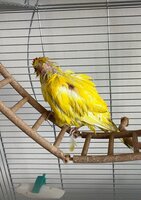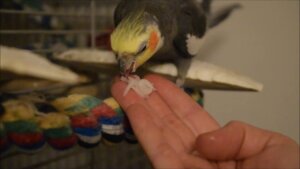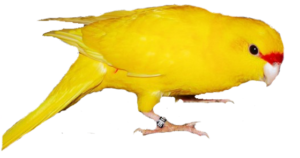Why Is My Kakariki Losing Feathers? Discover the Causes
If your Kakariki is losing feathers, it can be concerning. Feather loss can signal several issues, from health problems to environmental factors.
Kakarikis, known for their vibrant colors and playful nature, are beloved pets. Feather loss in these birds, though, can worry any pet owner. It’s crucial to understand the causes behind this issue. Feather loss might be due to natural molting, stress, or underlying health problems.
Recognizing the signs early can help you address the issue promptly. This article will explore the common reasons your Kakariki might be losing feathers. By understanding these causes, you can ensure your feathered friend stays healthy and happy. Let’s dive into the details and find out what might be troubling your pet.

Credit: www.rnz.co.nz
Common Causes Of Feather Loss
Feather loss in Kakariki birds can be alarming for any bird owner. Understanding the common causes can help you address the issue promptly. Let’s look at some common reasons why your Kakariki might be losing feathers.
Molting
Molting is a natural process where birds shed old feathers to make way for new growth. During this time, your Kakariki might look scruffy, but it’s usually nothing to worry about. Molting typically occurs once or twice a year and can last for several weeks.
| Signs of Molting | Duration |
|---|---|
| Feather shedding | Several weeks |
| Itching | Several weeks |
| Temporary bald spots | Several weeks |
Ensure your bird gets a balanced diet rich in vitamins and minerals during this period. Molting can be stressful, so provide a calm environment.
Stress
Stress can also cause feather loss in Kakarikis. Birds can become stressed due to various reasons such as changes in their environment, loud noises, or lack of interaction.
- Change in environment
- Loud noises
- Lack of interaction
- Improper diet
Make sure to keep your bird’s environment stable. Avoid sudden changes and loud noises. Spend time interacting with your Kakariki daily to keep them happy and stress-free.
Providing a proper diet is also crucial. Lack of essential nutrients can lead to stress and feather loss. Offer a variety of fruits, vegetables, and seeds to ensure a balanced diet.
By understanding these common causes, you can help your Kakariki maintain a healthy and full plumage.

Credit: www.reddit.com
Health Issues
Feather loss in Kakariki birds can be a sign of underlying health issues. It’s important to identify the cause promptly to ensure your bird’s well-being. Two common health-related reasons for feather loss are parasites and infections. Understanding these causes can help you take the right steps to treat your Kakariki.
Parasites
Parasites can cause significant feather loss in Kakarikis. Mites and lice are the most common parasites affecting these birds. They irritate the skin, leading to feather plucking and loss.
Look for these signs:
- Constant scratching
- Red or inflamed skin
- Visible mites or lice in the feathers
If you notice these symptoms, consult a vet immediately. They can recommend treatments like medicated sprays or powders to eliminate the parasites.
Infections
Infections can also cause your Kakariki to lose feathers. Bacterial, viral, and fungal infections are all possible culprits.
Common signs of infections include:
- Swollen or discolored skin
- Unusual discharge from the bird’s body
- Changes in behavior or appetite
Early detection is key. A vet can diagnose the specific infection and prescribe antibiotics or antifungal medications as needed.
Regular health check-ups can help prevent these issues. Keep your Kakariki’s environment clean and stress-free to promote overall health.
Nutritional Deficiencies
Feather loss in Kakarikis can be alarming. One common cause is nutritional deficiencies. A balanced diet is crucial for their health. Without it, they may lose feathers. Let’s explore some key aspects.
Lack Of Vitamins
Vitamins are vital for your Kakariki’s well-being. Vitamin A deficiency is a common issue. It leads to poor feather quality. This vitamin helps maintain skin and feather health. Without it, feathers become brittle and fall out.
Vitamin D is also important. Kakarikis need sunlight or supplements. Without enough Vitamin D, they may experience feather loss. Ensure your bird gets enough light. Consider adding a vitamin supplement to their diet.
Poor Diet
A poor diet can lead to feather loss. Kakarikis need a variety of foods. Seeds alone are not enough. Include fresh fruits and vegetables in their meals. They provide essential nutrients for feather growth.
Protein is another key element. Lack of protein can cause feathers to fall out. Offer your bird sources like eggs or cooked chicken. This helps maintain their feather health.
Observe their eating habits. Ensure they eat a balanced diet every day. This will help prevent nutritional deficiencies and feather loss.
Environmental Factors
Feather loss in Kakarikis can be a troubling issue. Environmental factors play a significant role in this condition. Understanding these factors can help you address and prevent further feather loss.
Temperature Changes
Kakarikis are sensitive to temperature changes. Sudden drops or spikes can stress them. Stress leads to feather loss. Keep their environment stable. Avoid placing their cage near windows or direct sunlight. Ensure a consistent room temperature, ideally between 65-75°F (18-24°C).
Humidity Levels
Humidity levels also impact Kakarikis. Low humidity dries out their skin and feathers. This causes them to molt excessively. Aim for a humidity level of 50-60%. Use a humidifier if necessary. Monitor humidity regularly to keep it within this range.
Behavioral Problems
Kakarikis are playful and active birds. Yet, behavioral problems can cause them to lose feathers. Understanding these behaviors can help you care for your pet better.
Feather Plucking
One common issue is feather plucking. Birds may pull out their feathers due to stress. It’s important to identify the cause. This behavior can lead to bald patches and skin infections.
- Stress: Changes in environment or loud noises can stress your bird.
- Infections: Mites or other parasites may cause irritation, leading to plucking.
- Diet: A poor diet can affect feather health. Ensure a balanced diet.
Boredom
Boredom is another reason for feather loss. Kakarikis need mental stimulation. Without it, they may start plucking feathers out of frustration.
To prevent boredom:
- Provide toys. Rotate them to keep your bird interested.
- Spend time with your bird. Social interaction is crucial.
- Allow for flight time. Exercise helps reduce boredom.
Ensuring your bird stays active and engaged can help prevent feather plucking and other related problems.
Allergies
Is your Kakariki losing feathers? Allergies might be the culprit. Allergies can cause discomfort and feather loss in birds. Identifying the type of allergy can help you manage and reduce symptoms. Two main types of allergies affect Kakarikis: food allergies and environmental allergies.
Food Allergies
Food allergies occur when your Kakariki reacts to certain foods. Common allergens include nuts, seeds, and certain fruits. Symptoms may include feather plucking, sneezing, and itching. To identify food allergies, try an elimination diet. Remove one food at a time and observe changes. A vet can also conduct tests to pinpoint allergens.
Environmental Allergies
Environmental allergies stem from allergens in your Kakariki’s surroundings. Dust, pollen, and mold are common triggers. Symptoms include red eyes, sneezing, and feather loss. Keeping the cage clean helps reduce allergens. Use air purifiers and avoid using strong chemicals around your bird. Regular vet check-ups can help manage and treat environmental allergies.
Hormonal Changes
Your Kakariki might be losing feathers due to hormonal changes. These changes can occur for various reasons. Understanding these reasons can help you better care for your pet bird.
Breeding Season
During the breeding season, Kakarikis often experience hormonal fluctuations. These fluctuations can lead to feather loss. Feather loss in this period is usually temporary. It happens because their bodies prepare for mating and nesting.
Here are some signs that your Kakariki is in the breeding season:
- Increased vocalizations
- Nesting behavior
- Changes in appetite
If you notice these signs, your bird might be going through natural hormonal changes. Feather loss should resolve once the breeding season ends.
Age-related Changes
As Kakarikis age, they can experience hormonal shifts. These shifts may cause feather loss. Older birds might lose feathers more frequently. This is a normal part of aging and usually not a cause for concern.
To support your aging Kakariki, consider:
- Providing a balanced diet
- Ensuring a stress-free environment
- Regular vet check-ups
These steps can help maintain your bird’s health as they age. Always monitor your bird for other signs of illness. If feather loss seems excessive, consult a vet.
Preventative Measures
Preventing feather loss in your Kakariki is crucial. Taking simple steps can ensure their feathers remain healthy. Below, we explore essential measures to keep your bird’s feathers in top condition.
Balanced Diet
A balanced diet is vital for feather health. Ensure your Kakariki gets a mix of seeds, fruits, and vegetables. Fresh foods provide necessary vitamins and minerals. Avoid giving them too many sunflower seeds. These are high in fat and can lead to health issues. Offering a variety of foods ensures a good nutrient balance. Always provide clean, fresh water.
Regular Vet Check-ups
Regular vet check-ups are important. A vet can spot early signs of health issues. This helps prevent feather loss before it starts. Schedule annual visits for your Kakariki. If you notice unusual feather loss, visit the vet immediately. Early intervention can make a big difference. Your vet can also give advice on diet and care.

Credit: forums.avianavenue.com
Frequently Asked Questions
Why Is My Kakariki Losing Feathers?
Feather loss in Kakarikis can be due to stress, poor diet, or mites. Ensure a balanced diet and a stress-free environment. Consult a vet for a thorough check-up.
Is Feather Plucking Normal In Kakarikis?
Feather plucking is not normal and indicates underlying issues. It could be due to stress, boredom, or health problems. Seek veterinary advice.
How Can I Prevent Feather Loss In Kakarikis?
Provide a balanced diet, regular exercise, and mental stimulation. Keep the cage clean and free from parasites. Regular vet check-ups are essential.
Can Poor Diet Cause Feather Loss In Kakarikis?
Yes, a poor diet lacking essential nutrients can lead to feather loss. Ensure a varied diet with fresh fruits, vegetables, and quality bird feed.
Conclusion
Feather loss in Kakarikis can be alarming. Identifying the cause is crucial. Stress, diet, or parasites often contribute. Regular vet check-ups help ensure your bird’s health. Provide a balanced diet and a stress-free environment. Monitor your Kakariki closely for any changes.
Early detection can prevent serious issues. By taking these steps, you can help your Kakariki thrive.
Hello Dear, I'm Poli Kolymnia, owner of many birds (including budgies).
With a deep passion for these feathered companions, I'm here to share my expertise and extensive knowledge on birds care.
My articles cover essential topics like diet, housing, care, and health, providing practical tips to help you create a happy and thriving environment for your birds.





